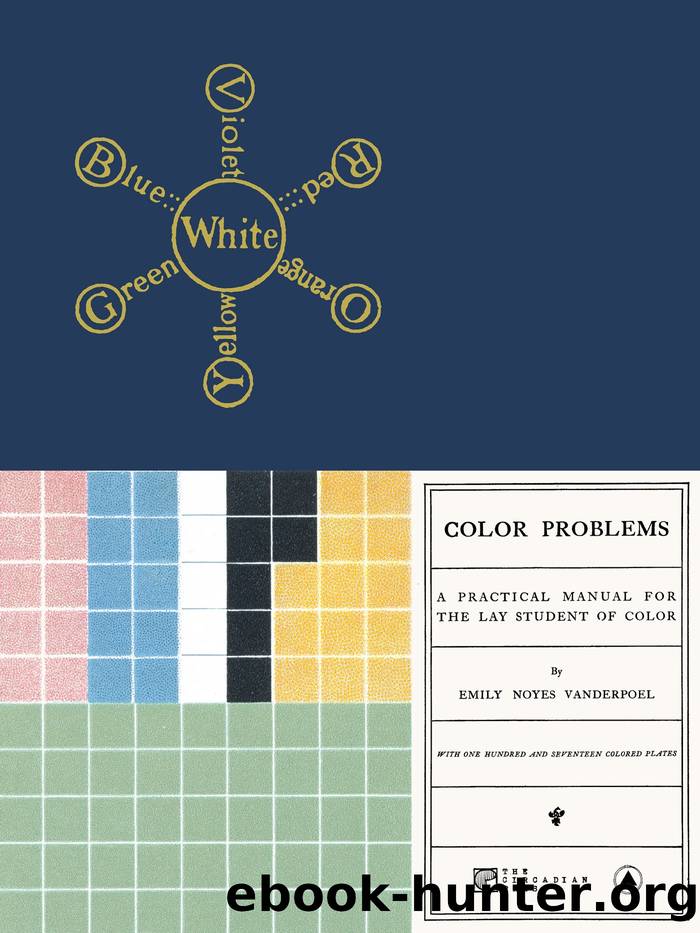Color Problems: A Practical Manual for the Lay Student of Color by Emily Noyes Vanderpoel

Author:Emily Noyes Vanderpoel
Language: eng
Format: epub
Publisher: Sacred Bones Books (Anthology Editions)
Published: 2018-01-15T00:00:00+00:00
âIt must not be imagined that the changes enumerated in the above table are at all equal to one another in amount. We have, indeed, always some change, but it varies much in the case of different pairs. When the chromatic interval (on the color-circle) is small, then the change of hue, in virtue of simultaneous contrast, is large; when the interval is large the change of hue is slight, but it is accompanied by change of brightness; when the interval is as large as possible there is no change of hue, but the brightness of both hues is increased.â
After simultaneous contrasts Chevreul gives us successive contrasts, which latter âmay be observed when we tire one set of retinal fibrils by gazing for some time on a surface of a very decided color and brightness. Afterward, on looking at a colorless surface of white, gray, or black, it will be found to be tinctured with the complementary of the first color.â If we stare at a piece of bright red paper and then look at white paper we will see blue-green, the complement of the red. So, if we look at a series of pieces of red cloth the first will appear the brightest, the second less so, the third still less, but if the eye is rested by looking at a piece of bluish-green cloth the red will then be seen of its original brightness. When a black spot laid on red cloth is looked at steadily for some time, then is taken suddenly away, the place where the black spot was will appear to be of a brighter red than that around it on account of the less fatigue there has been to that part of the retina. A salesman who understood complementary colors could use this law of successive contrasts with great effect in showing goods.
Still another form of contrast is called mixed contrast. âThe distinction of simultaneous and successive contrast renders it easy to comprehend a phenomenon which we may call mixed contrast; because it results from the fact that the eye, having seen for a time a certain color, acquires an aptitude to see for another period the complementary of that color and also a new color, presented to it by an exterior object; the sensation then perceived is that which results from this new color and the complementary of the first. The following is a very simple method of observing this mixed contrast: One eye being closed, the right for instance, let the left eye regard fixedly a piece of paper of the color A; when this color appears dimmed, immediately direct the eye upon a sheet of paper colored B; then we have the impression which results from the mixture of this color B with the complementary color, C, of the color A. To be satisfied of this mixed impression it is sufficient to close the left eye, and to look at the color B with the right: not only is the impression
Download
This site does not store any files on its server. We only index and link to content provided by other sites. Please contact the content providers to delete copyright contents if any and email us, we'll remove relevant links or contents immediately.
Kathy Andrews Collection by Kathy Andrews(11730)
The remains of the day by Kazuo Ishiguro(8823)
Paper Towns by Green John(5091)
Spare by Prince Harry The Duke of Sussex(5072)
Industrial Automation from Scratch: A hands-on guide to using sensors, actuators, PLCs, HMIs, and SCADA to automate industrial processes by Olushola Akande(4982)
The Body: A Guide for Occupants by Bill Bryson(4974)
Machine Learning at Scale with H2O by Gregory Keys | David Whiting(4183)
Be in a Treehouse by Pete Nelson(3948)
Never by Ken Follett(3791)
Harry Potter and the Goblet Of Fire by J.K. Rowling(3775)
Goodbye Paradise(3728)
Into Thin Air by Jon Krakauer(3313)
The Remains of the Day by Kazuo Ishiguro(3293)
The Cellar by Natasha Preston(3262)
The Genius of Japanese Carpentry by Azby Brown(3224)
Fairy Tale by Stephen King(3220)
120 Days of Sodom by Marquis de Sade(3182)
The Man Who Died Twice by Richard Osman(2997)
Drawing Shortcuts: Developing Quick Drawing Skills Using Today's Technology by Leggitt Jim(2996)
